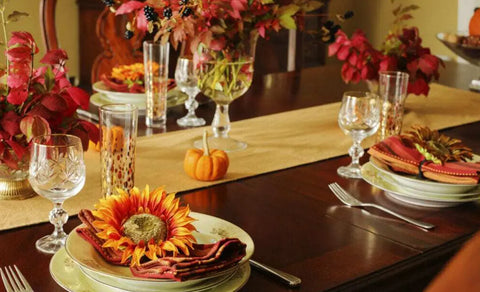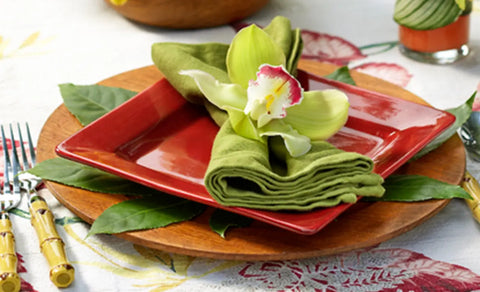Table settings have evolved over time, with modern styles differing greatly from vintage styles.
Modern table settings often feature clean lines, minimalistic design, and a focus on functionality. The use of neutral colors such as white, black, and gray is common, with the occasional pop of color provided by a colorful centerpiece or placemat. The emphasis is on simplicity and elegance, with a focus on showcasing the food rather than the table decor.
Vintage table settings, on the other hand, are characterized by their ornate design, rich colors, and attention to detail. Vintage table settings often feature intricate patterns and designs, such as lace or embroidery. The use of vintage china and silverware is also common, with an emphasis on creating a sense of nostalgia and elegance.

One of the most important elements of any table setting is the table spoon. This versatile piece is used for everything from stirring sugar into coffee to scooping up a heaping serving of mashed potatoes. However, these also differ for modern and vintage table settings. Modern table spoons often feature sleek, minimalist designs that are perfect for contemporary dining rooms. Vintage table spoons, on the other hand, can add a touch of nostalgia and elegance to any table setting. These older pieces may feature ornate designs, intricate engravings, or even family crests.
One of the key differences between modern and vintage table settings is the use of tablecloths. Modern table settings often do not use tablecloths, instead opting for a bare table or a placemat. Vintage table settings, on the other hand, often feature a white tablecloth as a base, with additional layers of lace or embroidered linens added for texture and visual interest.
Another important piece for any table setting is the olive spoon. These specialized utensils are specifically designed to remove olives from jars or bowls without damaging the delicate fruit. Modern olive spoons often feature simple, functional designs that make them easy to use. Vintage olive spoons, however, can add a touch of charm and sophistication to any table setting. Theseolder pieces may feature intricate designs or even be made of precious metals
like silver or gold.

Another difference between modern and vintage table settings is the use of centerpieces. Modern table settings often feature simple, understated centerpieces, such as a single flower in a vase or a small bowl of fruit. Vintage table settings, on the other hand, often feature more elaborate centerpieces, such as candelabra or large floral arrangements.
When we talk about coffee spoons, they are a must-have for any table setting. These small, specialized utensils are designed to be used with coffee cups, and are perfect for stirring in sugar or cream. Modern coffee spoons often feature simple, minimalist designs that are perfect for contemporary dining rooms. Vintage coffee spoons, on the other hand, can add a touch of nostalgia and elegance to any table setting.
When it comes to seating arrangements, modern table settings often feature a more relaxed, informal seating arrangement, with guests seated around a large table or island. Vintage table settings, on the other hand, often feature a more formal seating arrangement, with guests seated at a long table and assigned seating.
In terms of overall aesthetic, modern table settings are sleek and contemporary, while vintage table settings are more traditional and ornate. Both styles have their own unique charm and can be used to create a variety of different looks and moods.
Another key difference between modern and vintage table settings is the use of technology. Modern table settings often incorporate technology, such as digital menus, electronic candles, and even charging stations for guests' smartphones. Vintage table settings, on the other hand, do not typically incorporate technology, instead relying on traditional elements such as candles, printed menus, and hand-written place cards.
When it comes to tableware, modern table settings often feature simple, understated dishes and glassware, with a focus on functionality and durability. Vintage table settings, on the other hand, often feature more ornate and delicate tableware, such as intricate patterns and designs, gold or silver accents, and crystal glassware.
In terms of overall ambiance, modern table settings tend to create a more casual and relaxed atmosphere, with a focus on comfort and ease. Vintage table settings, on the other hand, tend to create a more formal and elegant atmosphere, with a focus on tradition and ceremony.

It is also important to consider the occasion when choosing between modern and vintage table settings. Modern table settings are often used for casual gatherings, such as family dinners or casual business meetings, whereas vintage table settings are often used for more formal occasions, such as weddings, anniversary parties, and holiday celebrations.
Another important consideration is the budget. Vintage table settings can be quite expensive, as they often require the rental or purchase of vintage china, silverware, and linens. Modern table settings, on the other hand, are generally more affordable, as they typically require less elaborate and expensive decor.
In conclusion, both modern and vintage table settings have their own unique appeal and can be used to create a variety of different looks and moods. Modern table settings are sleek and contemporary, featuring clean lines and minimalistic design, while vintage table settings are traditional and ornate, characterized by rich colors and intricate patterns. The choice between these two styles depends on personal preference, the occasion, and the budget. It is also important to consider the overall theme, and ambiance.



